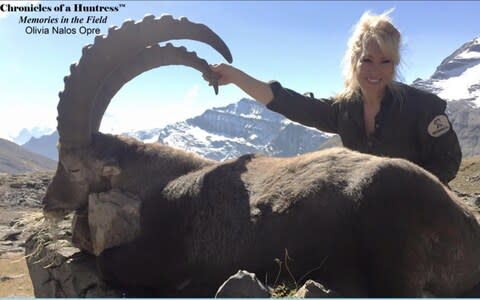Calls for Swiss ban on foreign 'trophy hunters' shooting the country's iconic ibex

Tens of thousands of Swiss citizens are calling for an end to "trophy hunting" of the country’s iconic ibex by foreigners who pay up to £15,000 to shoot the long-horned ruminants at close range.
Some 46,000 have signed a petition in the past two week in the wake of a TV investigation showing big game hunters scaling Alpine peaks to kill the beasts as they graze.
The Alpine ibex, a species of wild goat, was once plentiful in Europe and the remains of one individual were found inside Otzi the Iceman, the 5,300-year-old hunter discovered in a glacier.
Hunted almost to extinction in Europe, its population has recovered to around 40,000.
While ibex enjoy total protection in neighbouring France and Italy, they can be hunted in two cantons of Switzerland, Valais and Graubünden, where their status is "unfavourable-inadequate" – meaning conservation is required but the numbers are not critical.

Valais has discreetly allowed foreign trophy hunters to shoot 120-odd individuals for the past 40 years, making half a million pounds a year from the lucrative “sport” and charging hefty fees for them to cart off their prized horns.
But the decades-old practice came to public attention in dramatic fashion last week when a Swiss TV report showed guides bringing trophy hunters within yards of the majestic beasts and shooting them at close range before posing with the dead animals. Their heads were cut off and the body left on the mountainside.
Among the clients was Olivia Nalos Opre, a high-profile American huntress who has previously defended the slaying of Cecil, a lion in Zimbabwe, which sparked global outrage.
In a Skype interview with RTS, Ms Opre, who travels the world felling game including lions and rhino, described her experience as “a wonderful adventure in the Alps”.
“We were guided by wildlife rangers to flush out the animals. I was able to shoot a male ibex, a big, powerful one. My friend Denise shot two, including a trophy of over a metre,” she said.
She posted photos of her hunting experience on her Facebook page.

A licence to shoot a male ibex with one-metre-long (3.3ft) horns – the biggest prize – costs 13,000 Swiss francs (more than £10,000). Ms Opre, 42, said the three-day trip cost her about £15,000. By comparison, it costs around £5,000 to fell a giraffe £23,000 to shoot a lion.
Posing as would-be clients, Swiss TV journalists contacted travel agencies selling ibex hunting packages. Some offered to go on “special hunts” to shoot French and Italian ibex – protected in those countries – that strayed over the border for those wishing to fell a “really exceptional animal”.
Prof Ulf Büntgen of the Swiss environmental research institute WSL defended controlled ibex-hunting.
"Switzerland's strictly regulated hunting is conserving the population – in Graubünden they are very careful about which animals are harvested, and where.
"It lives very high up – most visitors never see one. It's very shy and you have to climb with a local ranger, to spot the right animal, of the right age and gender.
"If you kill the wrong animal you pay a fine and get nothing, and you could lose your licence."
But Christian Fellay of the Valais hunting federation society, said trophy hunters were taken to locations where near-tame beasts were lured via salt licks and thus sitting targets.
“This has strictly nothing to do with hunting, it’s like an organised funfair gallery shoot,” he said.
“They walk for a few metres with two sticks, arrive and shoot an ibex at ten metres. It’s the antithesis of the passion of hunting. And for the past 40 years, Valais has let people with the financial means shoot (them).”
Shocked by the images of ibex in their death throes, Nicole Maret, who lives in Valais, launched a petition calling for locals “to show that they are against this shameful hunting”.
“I was flabbergasted when I saw this on the television,” she told Le Temps. “I’ve signed petitions against animal exploitation around the world but what I was seeing was taking place on my doorstep.”
Almost 40,000 people had signed the petition within three days.
“These tourists can find horns to decorate their living rooms simply by walking in the mountains,” she added. “We are angry and want the state to intervene.”
In total, about 450 ibex are shot annually in Valais, and 500 in Graubünden, where 40 per cent of Switzerland's ibex live.
The director of the Valais hunting department Peter Scheibler said only old animals were shot during these safaris, “many of which would not survive the winter, anyway”.
But Jean-Michel Gaillard, research director at the French National Centre for Scientific Research, CNRS, said the species' gene pool was at risk.
“Ibex with long horns are the oldest. These powerful males are the ones who reproduce, not the young ones.
“If too many are culled, the balance of the herds is threatened,” he told RTS.
In the wake of the uproar, Jacques Melly, the state politician in charge of local hunting policy, said that since April, talks had been underway to decide if ibex trophy hunts should, in fact, be banned. A decision would likely be made within two years, he said.
“But in any case, 450 ibex in Valais need to be culled each year," to regulate numbers, he insisted.
